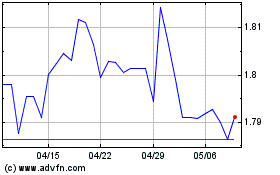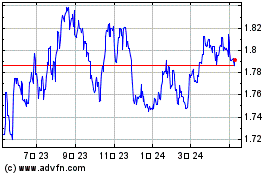Euro Slides After Soft Eurozone Inflation
The euro weakened against its most major counterparts in the
European session on Thursday, as Eurozone inflation slowed in
April, putting pressure on the ECB policy makers over the exit of
the bond buying programme that ends in the autumn.
Data from Eurostat showed that inflation eased to 1.2 percent in
April from 1.3 percent in March. The rate was expected to remain
unchanged at 1.3 percent.
Core inflation that excludes energy, food, alcohol and tobacco,
slowed more-than-expected to 0.7 percent from 1 percent in March.
Economists had forecast a rate of 0.9 percent for April.
Separate data showed that the producer price inflation increased
to 2.1 percent in March from 1.6 percent in February.
Excluding energy, producer price growth eased to 1.4 percent
from 1.6 percent in February.
Weak inflation data may trigger caution to the ECB policy
makers, who are looking to exit its $3 trillion quantitative easing
program that runs until September.
European shares fell, as investors awaited the outcome of
Sino-U.S. trade talks and assessed new earnings reports.
Investors digested the outcome of the latest Fed meeting. The
Fed left interest rates unchanged, as widely expected, and signaled
that the gradual path of rate hikes will stay.
The currency traded mixed against its major counterparts in the
Asian session. While it held steady against the yen and the franc,
it rose against the greenback and the pound.
The euro retreated to 0.8807 against the pound, off early
session's high of 0.8831. Next key support for the euro is likely
seen around the 0.87 level.
Survey data from IHS Markit showed that the U.K. service sector
rebounded in April following the snow disruptions seen in
March.
The services PMI rose to 52.8 in April from 51.7 in March.
Nonetheless, the reading was below the forecast of 53.5.
The euro was trading lower at 1.1970 against the greenback, down
from a high of 1.2009 hit at 3:45 am ET. The next possible support
for the euro is seen around the 1.18 area.
The single currency weakened to 130.80 against the yen, its
weakest since April 4. The euro is poised to challenge support
around the 128.00 mark.
The euro slipped to a 2-week low 1.5891 against the aussie and a
10-day low of 1.7013 against the kiwi, from its early highs of
1.5967 and 1.7100, respectively. The euro is likely to find support
around 1.57 against the aussie and 1.69 against the kiwi.
Reversing from an early high of 1.5420 against the loonie, the
euro edged down to 1.5366. If the euro continues its fall, 1.52 is
possibly seen as its next support level.
On the flip side, the euro climbed to 1.1962 against the franc,
reversing from an early low of 1.1936. The euro is seen challenging
resistance around the 1.22 area.
Looking ahead, U.S. factory orders for March and ISM
non-manufacturing composite index for April are scheduled for
release in the New York session.
Euro vs NZD (FX:EURNZD)
FXチャート
から 3 2024 まで 4 2024

Euro vs NZD (FX:EURNZD)
FXチャート
から 4 2023 まで 4 2024
